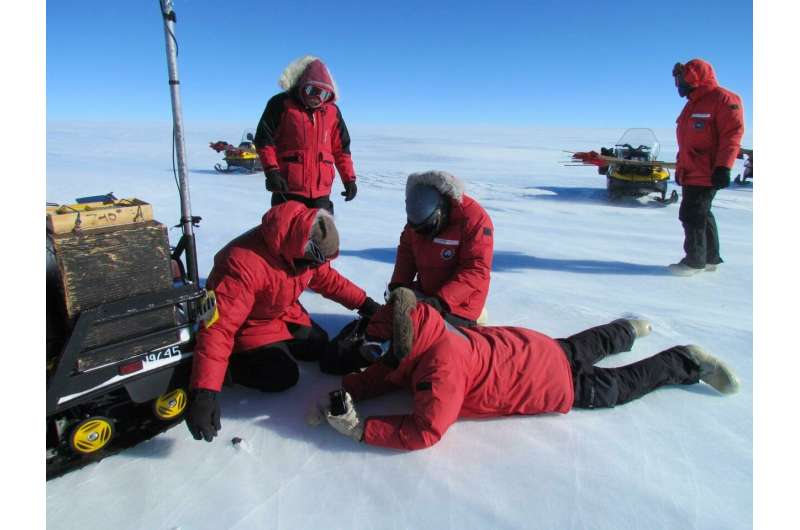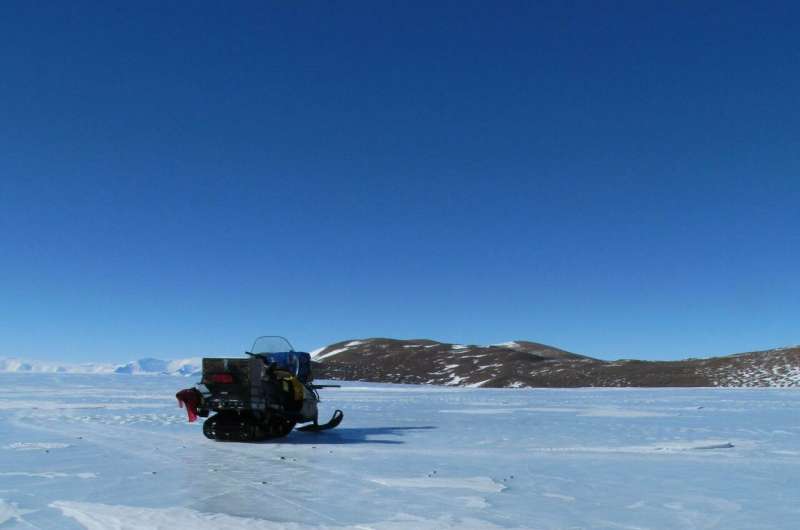Sample collecting of meteorites in Antarctica. Credit: Katherine Joy / ANSMET
An international study led by researchers from the Institute of Space Sciences, from the Spanish National Research Council (CSIC) and the Institut d'Estudis Espacials de Catalunya has discovered that carbonaceous chondrites, a class of meteorites, incorporated hydrated minerals along with organic material from the protoplanetary disk before the formation of planets. The researchers, who have published their results in the journal Space Science Reviews, note that these meteorites played "an important role in the primordial Earth's water enrichment" because they facilitated the transportation of volatile elements that were accumulated in the external regions of the so-called protoplanetary disk from which planets were formed.
Carbonaceous chondrites come from asteroidal bodies of smaller than hundred kilometres that never melted or experienced internal chemical differentiation as planets did. Thus, the study gives clues about the initial accretion phases of the first bodies that accreted to form the planets. The meteorites analysed in this work belong to the NASA's Antartic collection, meteorites that fell in Murchison (Australia) in 1969, and in Renazzo (Italy) in 1824. Representative samples of the two more-hydrated types of carbonaceous chondrites (CM and CR groups) have been studied.
"Chondrites constitute a fossil legacy of the creation of the planetesimals, which provide information about the accretion of the first building blocks of planets, and also about everything that happened inside them shortly after their formation. In this study, we want to go a step further to identify processes of water incorporation that happened in the protoplanetary disk," explains CSIC researcher Josep M. Trigo-Rodríguez, who works at the Institute of Space Sciences and has led the study.
He says, "There is a great debate about the origin of water on Earth and our study proves that carbonaceous chondrites were able to transport water in a very efficient way in their matrices. That water seems to come from two types of objects formed at different distances from the sun: hydrated asteroids and comets. Obviously, in order to know the origin of water on Earth, we must study not only the comets but also the carbonaceous chondrites that come from the transitional asteroid population. These were far more numerous 4,000 million years ago, but suffered a gravitational destabilisation during Jupiter and Saturn's migration to their current orbits. Those that did not end being swallowed by Jupiter and Saturn were ejected toward the terrestrial planets and to other regions of the solar system, transporting water and organic material inside them," explains the CSIC researcher.
Sample collecting of meteorites in Antarctica. Credit: Katherine Joy / ANSMET
The study also points at the direct implications for the origin of water in Earth. "Our calculations indicate that, coinciding with the so-called Heavy Bombardment produced by the gravitational destabilisation of the main asteroid belt, billions of tons of carbonaceous chondrites reached Earth about 3,800 million years ago. And they did it transporting in their fine matrices water and other volatile elements in form of hydrated minerals," says Trigo.
Currently, there are two ongoing missions for sample returns from primitive asteroids: NASA's OSIRIS-Rex and JAXA's Hayabusa 2. The results from the carbonaceous chondrite analysis at a micro- and nanoscale that are published in this new study reveal the importance of the sample-return missions, which will bring to Earth rocks less altered by collisions than the meteorites that land on the terrestrial surface.
More information: Josep M. Trigo-Rodríguez et al, Accretion of Water in Carbonaceous Chondrites: Current Evidence and Implications for the Delivery of Water to Early Earth, Space Science Reviews (2019). DOI: 10.1007/s11214-019-0583-0
Provided by Spanish National Research Council (CSIC)
























